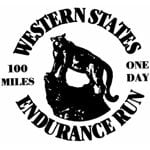 In the week before the 2015 Western States 100, we’ve interviewed Rob Krar, Jared Hazen, Ryan Bak, and Gediminas Grinius. Rob is the WS 100 defending champion, Jared is back for his second States after finishing 14th last year, Ryan Bak is taking on Krar and States as his first 100 miler, and Gediminas is hoping to improve on his very strong 2014 and early 2015 in international ultramarathons.
In the week before the 2015 Western States 100, we’ve interviewed Rob Krar, Jared Hazen, Ryan Bak, and Gediminas Grinius. Rob is the WS 100 defending champion, Jared is back for his second States after finishing 14th last year, Ryan Bak is taking on Krar and States as his first 100 miler, and Gediminas is hoping to improve on his very strong 2014 and early 2015 in international ultramarathons.
In the following interviews, Rob talks about why he’s back to race States for a third time, Jared tells us how he’s going to go for it with his race strategy, Ryan argues for why he should be considered a contender despite his limited ultra experience, and Gediminas talks about what it means to run States as an international competitor.
You can also jump immediately to interviews with:
Be sure to check out our in-depth men’s preview as well as our other set of written interviews with Seth Swanson, Ryan Sandes, Dylan Bowman, and Brendan Davies to see who else will join these guys in the men’s race.
Rob Krar
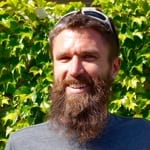
Rob Krar
iRunFar: Two WS 100 finishes, one second place, one win, a 14:53 finish last year. What more can a guy ask for? Why are you back? What unfinished business do you have with this course? The competition? Something else?
Rob Krar: I don’t think I ever questioned if I’d return to Western States; it was really a given for me. There’s so much emotion and so many memories packed into such a short relationship with the race. The first time I really became aware of the race was shortly after Tim Olson won the race in record time in 2012. I remember seeing a photo of him on the Placer High School track just after finishing the race, thinking what a badass he was, and also how preposterous it was to think of what he’d just done. How ironic when a year later I found myself in that very spot, sitting in a chair being interviewed by John Trent after finishing second to Tim in a race I still thought preposterous. The seed was planted at that moment and without having to think much of it, winning Western States in 2014 was my goal.
It had been too long since I’d set such a lofty goal for myself–it was refreshing and energizing and gave me the confidence to feel I belonged in ultrarunning and was in it for the long haul. It was a challenging year for many reasons and to realize my goal after the hard work and sacrifice was immensely satisfying and fulfilling.
The race seems to draw the best out of everyone and this year will be no different. I’m back to visit the dark place I go to, to explore and learn more of the very extremes of my body and mind. There’s no better platform to do this than Western States.
iRunFar: You have made clear in your last couple years–during your foray into trail ultrarunning–that you are a man who goes on an emotional journey when you race, in addition to the physical journey. And you’ve also made clear that not all the emotional journeys you take are good ones, that you find yourself sometimes in dark places. Can you talk about that place? What it feels like? How being there ends up helping you and your life? And how about that place in contrast to the emotional highs that ultrarunning yields? What are those high points like for you?
Krar: I was honored to be asked to speak at the Medicine & Science Conference about this very topic–my experience with depression and ultrarunning–so I’ve thought a great deal of this the past few months. [Editor’s Note: The Medicine & Science in Ultra-Endurance Sports Conference takes place today and Wednesday in Squaw Valley, California.] I’m truly present when I go to my dark place. It’s a cathartic experience really, to harness and control the pain and welcome the emotions and deep focus that come with it. It’s a special experience and I’m so thankful each time I visit it. It’s almost a healing experience, a reminder that dark times will come and go, and it’s helped me to shift my mindset away from believing nothing good can come during the darkness of depression. Ultrarunning, especially a 100-mile race, can be a wonderful metaphor and reminder that life is full of pain and joy and are natural paths of the human experience.
iRunFar: What kind of internal dialogue are you having with yourself right now? Do you see last year’s win as pressure? A motivation tool? How are you feeling about your training? What happens to that internal dialogue when the gun goes off? Does it go quiet? Is it ‘talking with you’ while you’re racing?
Krar: The week or two before big races are always tough. I’m used to firing on all cylinders and crawling into bed feeling exhausted most nights, and when I begin to dial it in, cut back the miles and intensity, it feels strange and the internal dialogue can turn ridiculous. Thankfully I’ve had a great training block and I feel I have enough experience now to not question the rest and appreciate the final lead up to the race. I don’t take anything for granted and every race is its own. Wearing the M1 bib, while an honor, really has no bearing on the race for me. There are no shortcuts–it’s a new year, a new race, and I’ve had to step up my game just as everyone else has done.
The internal dialogue during the race can be a bit of a comedy–like a cartoon with an angel whispering into one ear and the devil in the other. My race at Leadville last year was the pinnacle of this–such a frightening yet rewarding experience. During my toughest moments of a race I work to remind myself of the hard work and sacrifice that led me to that moment, to be present and thankful. It’s always a battle out there, physically and mentally–it’s all part of the game.
iRunFar: The men’s field. I think the race is going to be all over the place the first 30 miles, then still all over the place with a slightly pared-down group until 50 miles, then a select few after that. Who’s still there with 40 to go? Thirty miles to go? Twenty? When, where, and how do you think the race will be decided?
Krar: It’s a long race on a hot day and it’s important to run my own race for as long as I can. The time will come to compete, but patience will take precedence. I’ve always said the smartest of the fastest runners will win the race and Saturday will be no different. I’ve never been one to speculate or put much worry into how a race might play out early on. It’s a stacked field with so many talented runners and a handful of potential winners, more if a dark horse has a magical day. The race begins at Foresthill and I wouldn’t be surprised if Cal Street makes or breaks the day for many and sorts out the podium at the end of the day.
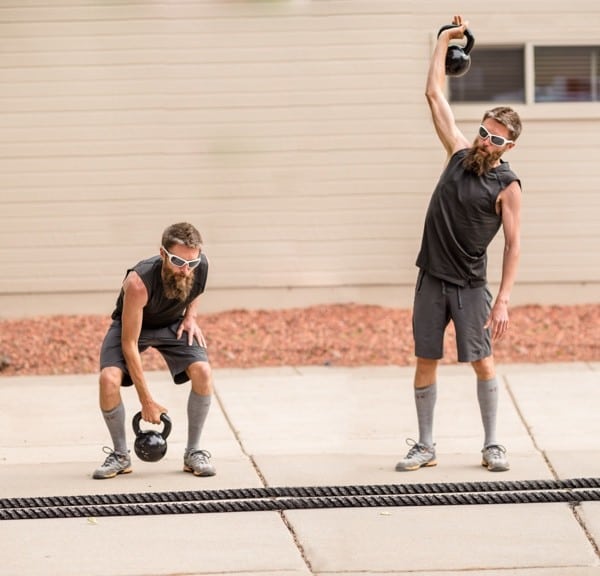
A double take as Rob Krar hits his circuit routine he dubs ‘The Equalizer.’ Photo: Myles Smythe/Michigan Bluff Photography
Jared Hazen

Jared Hazen
iRunFar: When I look at the men’s WS 100 roster, your name comes up in my mind as either the guy who’s going to have the biggest breakout or the guy who is going to blow up the most. You seem primed. You were 14th here at States last year, a good introductory, learning experience. Since then, you took third in a decent Bandera field and then third again at the super competitive Lake Sonoma. You’re 20, and you already have a decent amount of experience. How are you making sure that you’re going to be the one with the breakout and not the blow-up?
Jared Hazen: I think going into the race I’ve really set myself up to have a great day. I raced Bandera at the beginning of the year and took a lot of down time after that due to injury, then had a short and less-than-ideal seven-week build-up to Sonoma. After Sonoma, I took an easy two weeks and have been hitting the training really hard ever since then. I’m well rested and I feel really strong and fit.
As far as race day is concerned, I plan to run smart and keep a level head when things go wrong, because things will go wrong. I’m focused and feel ready to run hard for 100 miles. My head’s in the right spot, but it’s going to come down to making the right decisions during the race. Whether or not I can do that is something that is to be determined. A lot can go wrong in 100 miles and I think acknowledging that before the race is the best way to be ready for it.
iRunFar: Walk us through your race last year. How did it go for you? Where on the course did you excel? Where did you struggle? What did you learn that will help you this year?
Hazen: Last year, I was a bit intimidated running such a big race. I was very conservative for the first 78 miles and did my own thing,. I didn’t really care where I was in comparison to everyone else. I also spent a lot of time at the aid stations cooling off and making sure I was taking good care of myself. I ran the last 22 miles strong and was able to catch a lot of people. The climbs seemed to suit me well last year because they’re pretty similar to what I’m used to doing here in Colorado Springs, Colorado. Having said all that, I finished over 2.5 hours after Rob. I know this year I’ll have to take a few more risks early on if I want to be at the front of the race.
iRunFar: Are you going to go for it?
Hazen: I’m going for it! I’ve worked really hard to qualify for this race and the training block I just finished was the most intense of my entire life. I feel too invested to finish the race giving anything less than my best. Sonoma was a big confidence booster for me. I ran with some top guys and felt strong all day. That race proved to me that I can run with some of the top guys who will be at States. It doesn’t mean I can beat them, but know I can at least hang around them for a good chunk of the race.
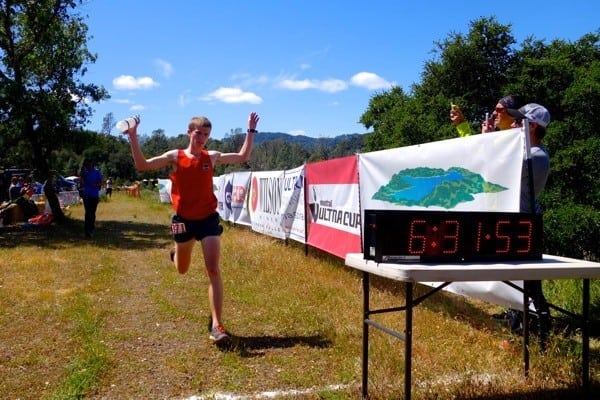
Jared at the 2015 Lake Sonoma 50 Mile. Photo: iRunFar/Bryon Powell
iRunFar: What motivates you to be an ultrarunner? You’re at that point in your life where, literally, the world is your oyster. You could be anything, almost. What makes you choose ultrarunning? Or has it chosen you?
Hazen: The simple answer is that I just love it a lot. The three or so hours I get to spend running on the trails every day is the highlight of my day. Being outside, away from everything, just running in the woods or up in the mountains makes me really happy and it’s satisfying to do something every single day that you’re really passionate about. As far as racing is concerned, it’s about pushing my limits and doing things that I thought were impossible. It’s pretty interesting to test your body and see what you’re capable of. Ultrarunning has consumed me for the past two years since graduating high school. It affects every part of my life, my job, where I live, my friends. Sometimes it seems a bit excessive, but I wouldn’t have it any other way.
Ryan Bak

Ryan Bak
iRunFar: I’ve heard more than one time in the States lead-up, people think you could be the rabbit. You have incredible leg speed. You have no idea what the pace should be for 100 miles. You’re used to being at the front of most races you enter. You’re a relatively late entrant to the race so you haven’t had much time to mentally and physically prepare. What do you say to them?
Ryan Bak: You may see me near the front from the early stages of the race, but I will not be the rabbit at Western States. A lot of people think that I won’t be a serious contender because it will only be my second race over 50k and double the distance of my longest run ever (Lake Sonoma), but I think any competitor that is thinking those thoughts is making a mistake. I feel like I am in a great position being overlooked. No one expects me to really contend and that gives me some additional fuel for the fire to prove that I can compete with the best in longer ultra races.
I plan to run my own race and run within myself based on how my body feels on race day, but I do plan to gauge my efforts off of some of the key players who are experienced not only at the distance but also on the States course. However, I am not going to just follow blindly at all times as my current skill set is slightly different. For example, I am not going to hammer the downhills with reckless abandon the way that some people like to, but I plan to make up time on the flatter sections of the course that play to my strengths.
iRunFar: This will be your debut 100 miler. You have great examples of people who have nailed their first 100 miles beautifully, and at this race, too: Rob Krar who took second in his a couple years ago; Stephanie Howe who won her first 100 miler here last year. Have you studied the races and experiences of ‘newbies’ who’ve not fallen prey to being the new person out there? What have you learned?
Bak: To be completely honest, I am as underprepared as you can be regarding course knowledge and race strategy for Western States. I haven’t studied the course map or the elevation charts and the only portions of the course that I have seen were the small patches covered during the Way Too Cool 50k. (And I really don’t even know what sections of WTC are part of the States course, so that really doesn’t help much.) I have had a couple of conversations with Stephanie and Max [King] regarding their preparations in 2014 and what they felt helped them the most in their training and what they learned from their racing strategies. It may sound like I am unprepared, but rest assured, I have put some serious training in. I have done lots of back-to-back long-run days and even a couple of back-to-back-to-back long runs (including Memorial Day weekend where I ran a solid 30 miles on Saturday, hammered 22 miles on Sunday, and then raced the Trail Factor 50k on Monday while also working on those days) and I have also pounded my quads to prepare for the descending at States. I am just not the type of person who studies maps and wants to know every inch of what is ahead. I’m sure I will encounter lots of surprises on the course and I like that.
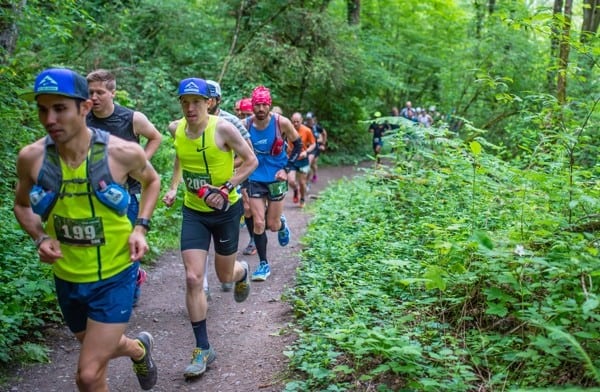
Ryan (bib #200) at the 2015 Trail Factor 50k. Photo: Paul Nelson
iRunFar: What attracts you to running 100 miles? In fact, what attracts you to running longer ultras at all? You’ve been very successful at shorter-distance running, and now shorter ultras. In a very short period of time you’ve advanced up the distance ladder from 50k’s to 50 miles and now 100 miles.
Bak: This is a tough question to answer because I don’t really know exactly what attracts me to running 100 miles, but it is a mix between the competition, wanting to prove that fast runners can also run fast at 100 miles, and the allure of Western States. Less than a year ago I thought that I would never have the desire to race 100 miles. The reason that I decided to even make a jump up to 50 miles and race Lake Sonoma was purely for the competition. On paper, the field was stacked up front and deep and I want to race where the best trail ultrarunners are racing so that I can test myself against the best. That aspect of competition has really driven me to look at longer races. The big 50-mile races (Lake Sonoma and The North Face Endurance Challenge 50-Mile Championship) seem to get more attention and draw a more competitive elite field than the bigger races at the 50k distance and below, so If I wanted to race against the best, I needed to move up in distance. Even with that said, I still did not imagine moving up to 100 miles. Going into Lake Sonoma, I told myself that I would definitely pass on a coveted WS 100 entry if I finished in the top two and earned it. However, after the race, I gave it some thought before just passing up the spot and the more I thought about it, the more it seemed like a challenge that I wanted to take on.
I race because I love to compete and to me running is the most pure and stripped-down form of athletic competition. Whenever I toe the line, I do so to compete and I always race to win. Personally, I would rather race to win and end up 20th knowing that I went for it and took the necessary chances to have a shot at winning, than I would want to race conservatively to secure second or third place.
iRunFar: You have a family. And a real job! A whole big world outside of ultrarunning! How have you fit in the specific preparations you’ve needed for States, getting in some big runs or big blocks of training? How have you made it all work?
Bak: I do have a family and a real job, and I am probably a lot more like the majority of the iRunFar audience than a lot of the other elite runners. I am a real estate broker and I operate Team Bak at Fred Real Estate Group in Bend, Oregon along with my wife, Natalie. We have an 18-month-old son, Sawyer, and a new daughter who is expected to join us in early October. Natalie and Sawyer will be part of my crew at States. Luckily, there is some flexibility to my work schedule, however, I do work seven days most weeks and I definitely do not have the luxury of time to get in all of the training on the specific terrain that I would like to and I log a lot less hours in training than I did years ago when training for much shorter races. I am constantly trying to find more hours in the day that don’t exist and sleep is generally compromised in order to fit in family time, work, and training. For training, I fit in what I can and I don’t stress about what I miss. I try to make sure that I get in the important workouts and long runs and if some of the stuff in between gets pinched I don’t worry about missing a run. It’s not a perfect system by any means, but I do what I can to make it work. I have to thank my family for their support and understanding of training and racing, because it would not be possible without their flexibility.
Gediminas Grinius

Gediminas Grinius
iRunFar: Racing America’s Western States 100, it’s a bit of a thing of mythology in ultrarunning. Longstanding race, competitive race, a race that is partially responsible for building the American trail-ultra community. What’s it like to have a bib number for this race?
Gediminas Grinius: I started to dream about this race back in 2012, when I found out that such a run existed. As I went deeper into the race history, I became obsessed with the idea of participating in the WS 100. However, my chances of being drawn in the lottery were very weak, since a lot of runners apply for it each year. So, I tried to sneak in through Ultra-Trail World Tour slots, but I ended up getting lucky with a foreign-consideration entry along with Julien [Chorier] and François [D’Haene] a bit in advance. I feel really very proud and grateful to the WS 100 organization for being given the chance and their trust.
iRunFar: You’re kind of on a roll with your running. Fifth at UTMB last year, fourth at Diagonale des Fous last year, this year’s winner of Transgrancanaria. You finished 14th at the IAU Trail World Championships last month, which is still a strong result given the field that was there. What do your results have you thinking about your potential at Western States? What’s a best-case scenario for you here?
Grinius: Western States is kind of a different race from what I have done before. It can be hardly linked with UTMB and DdF, which are more technical. The only thing they have in common is the distance. So, my achievements in European-style races can’t be collated with WS 100, which is much faster and for the winner could take around 15 hours compared with 20 hours in UTMB or even longer in DdF. I really don’t know what my chances are in WS 100, where the race ends when in UTMB it just starts. One thing is obvious, I am not so fast and longer races suit me better. Still I will try to stick to the classic approach, I will stay in the back of the leaders and attack in the second part of the race. It is difficult to achieve here, as many use the same strategy: leaders try to survive till Foresthill and then those who still have the power in their legs try to win the race. I hope I will be among them.
iRunFar: You’ve been in the U.S. for a bit and recce-ing the Western States Trail. What parts of it have you seen and what do you think of it? What parts of the trail will suit your strengths and what parts of the trail will challenge you?
Grinius: Yes, I have reconnoitered the entire course from the Devil’s Thumb to the finish line in Auburn. I can’t say that it is the most picturesque trail, but definitely the two canyons will be the biggest challenge of the day, as it will be a hot afternoon, and halfway into the race. Those who will reach Michigan Bluff or Foresthill fresh will be the ones who will fight for the podium in the second half.
The most scenic part of the course, which I checked, goes from the Squaw Valley to Lyon Ridge. It is the kind of trail where I could spend my time running and never got bored, such amazing views all around. The WS 100’s course is quite runnable and it is my biggest challenge, as I prefer to have steep climbs where I can ‘rest’ and powerhike. However, here I have to do my best not to stop and keep running, which I am not used to.
iRunFar: You’ve raced some of the runners who will start next Saturday, and probably others you’ve seen in thumbing through race results. Who are you looking forward to racing against? What dynamic do you predict in the men’s field? Who is going to rabbit the group? Who will be an especially good hunter late in the race?
Grinius: I believe,that all the European trail runners will struggle as they, like me, are not used to this kind of racing. Experience, heat tolerance, and wise pacing will be the crucial components of this race and I bet Rob Krar has it all. If he has a bad day, Dylan Bowman or Ryan Sandes could make it their day. As for me I will run my own race against the heat and speed of WS 100 and I will try not to follow the guys whose pace I am definitely not able to sustain. But at the end of the day, I will try to hunt the hunter.
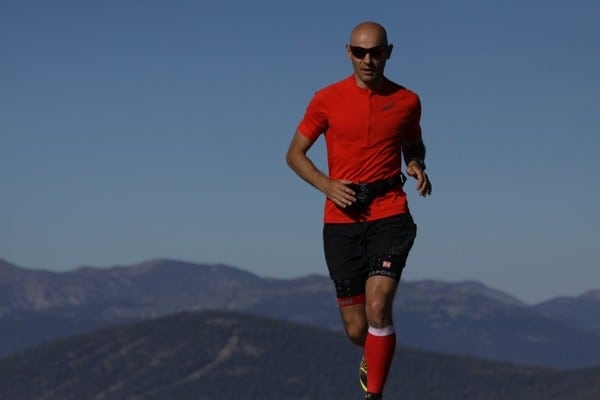
Gediminas training in the U.S. Photo courtesy of Gediminas Grinius.
